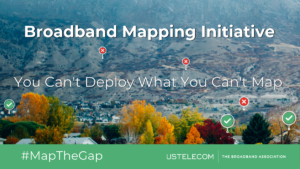August 1, 2019
From our technological prowess to vast public and private resources to emerging big data, our nation has the means to connect every American family, community and enterprise to high-speed internet. What we require now is collective will and a results-oriented path to get the job done. If we succeed, history could look back on this week as a modest but pivotal turning point.
Today, the Federal Communications Commission is expected to vote on two items that could define how, when, and to what extent we connect our nation. The first will begin crafting rules for a series of auctions to channel substantial public investment to help cover the cost of deploying high-speed broadband to unserved pockets of our nation. The second item seeks to harness big data to ensure finite public funds are surgically targeted to the estimated 10 million homes and businesses without access to the 21st century foundation of the American dream.
Both are essential to meaningful progress, and it’s encouraging to see them advancing in tandem. As with any rulemaking, the proposal voted on today begins a process of grinding out the programmatic nuts and bolts of the Rural Digital Opportunity Fund. As with any first draft, there is room for improvement—most notably in providing needed clarity in terms of how communities are transitioned from old to new support systems. Here are five key principles to help keep the conversation on track:
Technology Agnostic. Some concern has been expressed, primarily in the financial community, that new auction incumbent broadband providers no longer have a “right of first refusal” to receive public funds. It is noteworthy that little of this “hay” has been made by incumbent providers themselves. Across our policy advocacy, we have long made clear our desire to compete on a level playing field with cable, wireless, satellite and other market rivals. We believe we offer the superior service—faster and more reliable—to consumers, and we have the strongest track record on deployment at scale. We are confident these and other attributes will stand out in a competitive auction.
Make Sure Your Map Works. To fill in the gaps, we need a serious upgrade to our broadband GPS. Historic broadband connectivity measures have rendered too many unserved Americans invisible. Big data gives us the ability to obliterate these blind spots—and fast. After just four months, USTelecom’s proof-of-concept pilot is demonstrating the ability to quickly and cost-effectively pinpoint every business and household and ensure scarce federal resources reach communities in every corner of the nation.
Respect Finite Funds. With this new fund, the federal government is stepping up to the plate with $20.4 billion over 10 years to help overcome the upside-down economics of delivering essential modern infrastructure to sparsely populated areas. While significant, this pales in comparison to the private capital committed by incumbent providers. That’s why it is critical the FCC adopt improved broadband mapping to support broadband deployment — and also to advance fiscal responsibility. We must get the maps right and target broadband funding accordingly. Expect Congress to be very engaged at the intersection of connecting rural America and spending taxpayer funds wisely.
Eyes on the 5G Prize. Putting infrastructure in the ground means putting infrastructure dollars and jobs in the community. It also helps ensure all communities can participate in the 5G “wireless” revolution. I use air quotes because state-of-the-art wireless can’t exist at scale without state-of-the art wired networks. Take Wi-Fi in your home. How far does your content travel before hitting the router plugged into your wall? When out and about on your smartphone, how often do you spy cell towers taking your traffic to ground? Investing in lower quality internet beamed from space is the equivalent of a Betamax detour — bypassing the wired investments essential to connecting rural communities to 5G opportunity.
Don’t Drop the Baton. Two legs of a track and field relay can be undercut if there isn’t a strong handoff between runners. As old support mechanisms are phased out and new ones take their place, it is imperative any FCC order not burden only one part of our fiercely competitive broadband ecosystem. Instead, it is essential the transition be orderly and not leave rural communities and the companies that serve them in the lurch.
The FCC has begun an important conversation about our connected future. It may not be front-page news, but it could well have lasting impact. They say the devil is in the details. But so are the solutions to some of our country’s most intractable challenges. A truly connected nation is in our sights. Our nation’s broadband companies look forward to working with any and all allies with the collective will to help finish the job.
This article originally appeared August 1st in Morning Consult.
